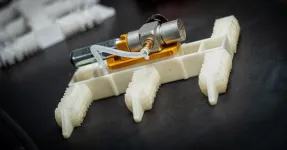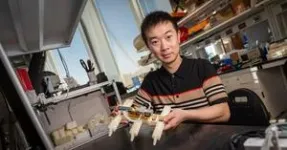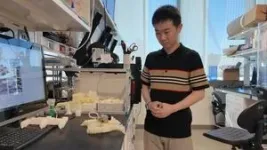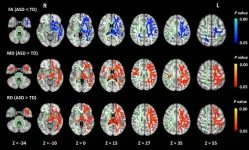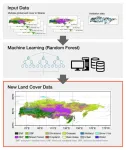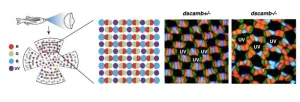(Press-News.org) Imagine a robot that can walk, without electronics, and only with the addition of a cartridge of compressed gas, right off the 3D-printer. It can also be printed in one go, from one material.
That is exactly what roboticists have achieved in robots developed by the Bioinspired Robotics Laboratory at the University of California San Diego. They describe their work in an advanced online publication in the journal Advanced Intelligent Systems.
To achieve this feat, researchers aimed to use the simplest technology available: a desktop 3D-printer and an off-the-shelf printing material. This design approach is not only robust, it is also cheap—each robot costs about $20 to manufacture.
“This is a completely different way of looking at building machines,” said Michael Tolley, a professor in the UC San Diego Department of Mechanical and Aerospace Engineering and the paper’s senior author.
These robots could be used in settings where electronics cannot function. For example, the robots could be used for scientific reconnaissance in areas with strong radiation, or for disaster response or space exploration.
The researchers tested the robots in the lab and showed that as long as they were connected to a source of air or gas under constant pressure, they could keep functioning non-stop for three days. The team also showed that the robots could walk outdoors, untethered, using a compressed gas cartridge as a power source, and traverse different surfaces, including turf and sand. The robot can even walk underwater.
The goal was not only to design robots that could walk right off the printer, with the addition of an air power source but also to do so with flexible, soft materials. “These robots are not manufactured with any of the traditional, rigid components researchers typically use,” Tolley said. Instead, they are made of simple 3D-printing filament.
The biggest challenge was creating a design that would include artificial muscles and a control system, all printed out of the same soft material, in a single print. The team, led by postdoctoral scholar Yichen Zhai in Tolley’s research group at the UC San Diego Jacobs School of Engineering, adapted a 3D printing technique that they used previously to build an electronics-free gripper. Their efforts led to the fabrication of a six-legged robot. “We have taken a giant leap forward with a robot that walks entirely on its own,” Zhai said.
To drive the robots to move, the team created a pneumatic oscillating circuit to control the repeated motions of soft actuators, similar to the mechanism that drove a locomotive’s steam engine. The circuit coordinates the movement of the six legs by delivering air pressure at the right time alternating between two sets of three legs. The robots' legs are capable of moving in four degrees of freedom—up and down, forward and back, which in turn allows the robot to walk in a straight line.
Next steps include finding ways to store the compressed gas inside the robots and using recyclable or biodegradable materials. The researchers are also exploring ways to add manipulators, such as grippers, to the robots.
Tolley’s lab partnered with the BASF corporation through their California Research Alliance (CARA) to test various soft materials that could be used on standard 3D printers. Some of the high-end materials they tested are not commercially available, but researchers also successfully printed the robots with off-the-shelf, standard materials.
In addition to their collaboration with BASF, the work was partially funded by the National Science Foundation.
Prior to this publication, the research team completed the 3D-printed walking robot in 2022 and showcased it at that year’s Gordon Research Conference on Robotics.
Monolithic Desktop Digital Fabrication of Autonomous Walking Robots
Yichen Zhai, Jiayao Yan, and Michael T. Tolley, UC San Diego Department of Mechanical and Aerospace Engineering
Albert De Boer and Martin Faber, BASF Forward AM
Rohini Gupta, BASF California Research Alliance
END
These electronics-free robots can walk right off the 3D-printer
2025-03-25
ELSE PRESS RELEASES FROM THIS DATE:
Dr. Vikaas Sohal of The University of California, San Francisco receives a $130,000 SynGAP Research Fund (SRF) grant to explore therapeutic strategies for reversing cognitive deficits in SYNGAP1-relat
2025-03-25
Mill Valley, CA – March 25, 2025 – The SynGAP Research Fund (SRF) dba Cure SYNGAP1 501(c)(3) announced a $130,000 grant to Dr. Vikaas Sohal at The Regents of The University of California, San Francisco. The grant supports research into new therapies for reversing cognitive deficits in SYNGAP1-related disorders (SRD) by enhancing key brain functions.
Dr. Sohal’s research focuses on cognitive flexibility—the ability to adapt behavior in response to environmental changes—a ...
Decoding autism through neuroimaging: how alterations in brain connectivity shape symptoms
2025-03-25
Autism spectrum disorder (ASD) is a growing global concern, affecting approximately 2.8% of children in the United States and 0.7% in China. ASD is characterized by challenges in social interaction, communication difficulties, and repetitive behaviors, making early diagnosis critical for improving outcomes. However, current diagnostic methods rely primarily on behavioral observations, which may delay early interventions. Despite ongoing research, the structural and functional brain differences between children with ASD and typically developing (TD) children remain poorly understood.
Now, in a recent study published in NeuroImage and made available online on February ...
Refining Siberia’s land cover data: A leap forward for climate science
2025-03-25
Siberia, a province located in Russia, is a significant geographical region playing a crucial role in the world’s carbon cycle. With its vast forests, wetlands, and permafrost regions (permanently frozen grounds), Siberia stores a considerable amount of carbon on a global scale. But climate change is rapidly altering Siberia’s landscape, shifting its vegetative distribution and accelerating the permafrost thaw. Classifying land cover is essential to predict future climatic changes, but accumulating land cover data in regions like ...
The evolution of low-temperature adapted enzymes
2025-03-25
Life has evolved over billions of years, adapting to the changing environment. Similarly, enzymes—proteins that speed up biochemical reactions (catalysis) in cells—have adapted to the habitats of their host organisms. Each enzyme has an optimal temperature range where its functionality is at its peak. For humans, this is around normal body temperature (37 °C). Deviating from this range causes enzyme activity to slow down and eventually stop. However, some organisms, like bacteria, thrive in extreme environments, such as hot springs or freezing polar waters. These extremophiles have enzymes adapted to function in harsh conditions.
For ...
Slowing down to eat less: towards simple strategies for obesity prevention
2025-03-25
Obesity is linked to numerous health complications, including diabetes, cardiovascular disease, and fatty liver disease. In a world where obesity rates continue to climb, researchers are constantly seeking effective, accessible solutions to this global health crisis. Interestingly, over the past few decades, scientists have begun to focus not only on what we eat but also on how we eat it.
While much attention has indeed focused on dietary content and caloric intake, emerging research suggests that eating behaviors—including meal duration, chewing speed, and number of bites taken—may ...
Study identifies link between high-salt diet and depression
2025-03-25
A new study published in The Journal of Immunology found that a high-salt diet (HSD) induces depression-like symptoms in mice by driving the production of a protein called IL-17A. This protein has previously been identified as a contributor to depression in human clinical studies.
“This work supports dietary interventions, such as salt reduction, as a preventive measure for mental illness. It also paves the way for novel therapeutic strategies targeting IL-17A to treat depression,” shared Dr. Xiaojun Chen, a researcher at Nanjing ...
Were large soda lakes the cradle of life?
2025-03-25
Along with nitrogen and carbon, phosphorus is an essential element for life on Earth. It is a central component of molecules such as DNA and RNA, which serve to transmit and store genetic information, and ATP (adenosine triphosphate), which cells need to produce energy.
Phosphorus may also have played a key role in the origin of life. Certain conditions are needed to trigger the start of the biochemical processes that precede life. One of these is the presence of sufficient phosphorus. Its availability regulates the growth and activities of organisms. Unlike nitrogen or carbon, however, phosphorus is relatively ...
Most in-depth simulation of brain metabolism yet reveals new targets for future dementia treatments
2025-03-25
The findings come from the most comprehensive computer model of brain metabolism to date, which incorporates more than 16,800 biochemical interactions between proteins and chemicals across brain cells, supporting cells, and the blood.
Scientists can now use this open-source model to find ways to prevent age-related diseases, such as dementia.“This study provides an x-ray view into the battery that powers the brain,” said Henry Markram, Professor of Neuroscience at École Polytechnique Fédérale de Lausanne (EPFL), Switzerland, the senior author of the study. “We can now track ...
USF study: Smartphones may benefit kids, but public social media use poses risks
2025-03-25
A full slide deck of findings is available at the Box link here
TAMPA, Fla. (March 18, 2025) – A groundbreaking new study of young people’s digital media use has revealed surprising results, including evidence that smartphone ownership may actually benefit children.
The study also suggests a link between social media posting and various negative outcomes, as well as data connecting cyberbullying to depression, anger and signs of dependence on digital media.
The Life in Media Survey, led by a team of researchers at the University of South Florida in collaboration with The Harris Poll, conducted a survey of ...
Study shows how retinal cells know when to keep their distance
2025-03-25
In vertebrate retinas, specialized photoreceptors responsible for color vision (cone cells) arrange themselves in patterns known as the “cone mosaic”. Researchers at the Okinawa Institute of Science and Technology (OIST) have discovered that a protein called Dscamb acts as a "self-avoidance enforcer" for color-detecting cells in the retinas of zebrafish, ensuring they maintain perfect spacing for optimal vision. Their findings have been published in Nature Communications.
Solving a mystery in vision science
Vertebrate retinas contain photoreceptor cells that convert light into neural signals. These photoreceptors come in two main types: rods, which function ...
